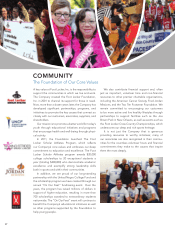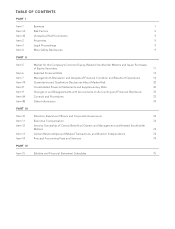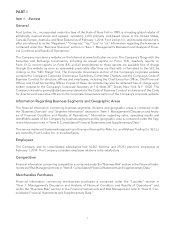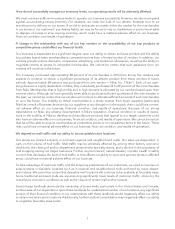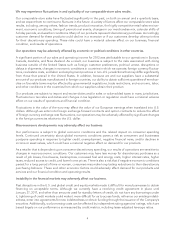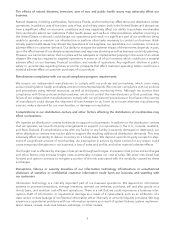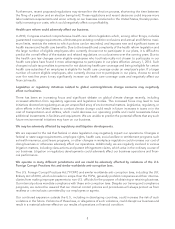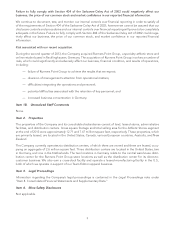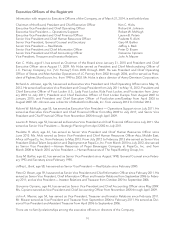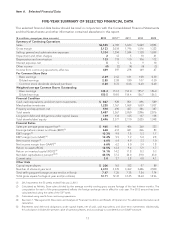Foot Locker 2013 Annual Report Download - page 28
Download and view the complete annual report
Please find page 28 of the 2013 Foot Locker annual report below. You can navigate through the pages in the report by either clicking on the pages listed below, or by using the keyword search tool below to find specific information within the annual report.We rely on a few key vendors for a majority of our merchandise purchases (including a significant portion from
one key vendor). The inability of key suppliers to access liquidity, or the insolvency of key suppliers, could lead
to their failure to deliver merchandise to us. Our inability to obtain merchandise in a timely manner from major
suppliers could have a material adverse effect on our business, financial condition, and results of operations.
Material changes in the market value of the securities we hold may adversely affect our results of operations
and financial condition.
At February 1, 2014, our cash, cash equivalents, and short-term investments totaled $867 million. The majority
of our investments were short-term deposits in highly-rated banking institutions. As of February 1, 2014, we had
$426 million of cash and cash equivalents held in foreign jurisdictions. We regularly monitor our counterparty
credit risk and mitigate our exposure by making short-term investments only in highly-rated institutions and by
limiting the amount we invest in any one institution. We continually monitor the creditworthiness of our coun-
terparties. At February 1, 2014, almost all of the investments were in institutions rated A or better from a major
credit rating agency. Despite those ratings, it is possible that the value or liquidity of our investments may
decline due to any number of factors, including general market conditions and bank-specific credit issues.
Our U.S. pension plan trust holds assets totaling $575 million at February 1, 2014. The fair values of these assets
held in the trust are compared to the plan’s projected benefit obligation to determine the pension funding
liability. We attempt to mitigate funding risk through asset diversification, and we regularly monitor investment
risk of our portfolio through quarterly investment portfolio reviews and periodic asset and liability studies.
Despite these measures, it is possible that the value of our portfolio may decline in the future due to any
number of factors, including general market conditions and credit issues. Such declines could have an impact
on the funded status of our pension plans and future funding requirements.
If our long-lived assets, goodwill or other intangible assets become impaired, we may need to record
significant non-cash impairment charges.
We review our long-lived assets, goodwill and other intangible assets when events indicate that the carrying
value of such assets may be impaired. Goodwill and other indefinite lived intangible assets are reviewed for
impairment if impairment indicators arise and, at a minimum, annually. As of February 1, 2014, we have $163
million of goodwill; this asset is not amortized but is subject to an impairment test, which consists of either a
qualitative assessment on a reporting unit level, or a two-step impairment test, if necessary. The determination
of impairment losses are significantly affected by estimates of future operating cash flows and estimates of fair
value. Our estimates of future operating cash flows are identified from our strategic long-range plans, which are
based upon our experience, knowledge, and expectations; however, these estimates can be affected by such
factors as our future operating results, future store profitability, and future economic conditions, all of which can
be difficult to predict accurately. Any significant deterioration in macroeconomic conditions could affect the fair
value of our long-lived assets, goodwill and other intangible assets and could result in future impairment
charges, which would adversely affect our results of operations.
Our financial results may be adversely affected by tax rates or exposure to additional tax liabilities.
We are a U.S.-based multinational company subject to tax in multiple U.S. and foreign tax jurisdictions. Our
provision for income taxes is based on a jurisdictional mix of earnings, statutory rates, and enacted tax rules,
including transfer pricing. Significant judgment is required in determining our provision for income taxes and in
evaluating our tax positions on a worldwide basis. Our effective tax rate could be adversely affected by a
number of factors, including shifts in the mix of pretax results by tax jurisdiction, changes in tax laws or related
interpretations in the jurisdictions in which we operate, and tax assessments and related interest and penalties
resulting from income tax audits.
A substantial portion of our cash and investments is invested outside of the U.S. As we plan to permanently
reinvest our foreign earnings outside the U.S., in accordance with U.S. GAAP, we have not provided for U.S.
federal and state income taxes or foreign withholding taxes that may result from future remittances of undistrib-
uted earnings of foreign subsidiaries. Recent proposals to reform U.S. tax rules may result in a reduction or
elimination of the deferral of U.S. income tax on our foreign earnings, which could adversely affect our effective
tax rate. Any of these changes could have an adverse effect on our results of operations and financial condition.
5


